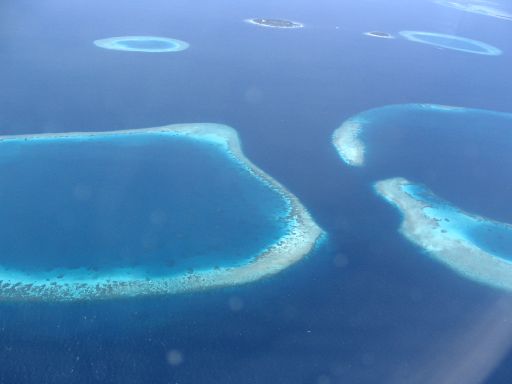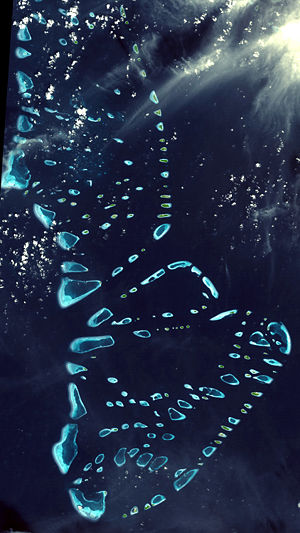Atolls of the Maldives EarthCache
-
Difficulty:
-

-
Terrain:
-

Size:  (not chosen)
(not chosen)
Please note Use of geocaching.com services is subject to the terms and conditions
in our disclaimer.

The word atoll comes from the Dhivehi (an Indo-Aryan language
spoken on the Maldive Islands) word atholhu. Its first recorded use
in English was in 1625 as atollon. However, the term was
popularised by Charles Darwin, who described atolls as a subset in
a special class of islands, the unique property of which is the
presence of an organic reef. More modern definitions of atoll are
those of McNeil as "...an annular reef enclosing a lagoon in which
there are no promontories other than reefs and islets composed of
reef detritus" and Fairbridge "...in an exclusively morphological
sense, [as] ...a ring-shaped ribbon reef enclosing a lagoon in the
center." Formation:

Darwin explained the creation of coral atolls in the South Pacific
(1842) based upon observations made during a five-year voyage
aboard the HMS Beagle (1831–1836). His explanation, which is
accepted as basically correct, involved considering that several
tropical island types—from high volcanic island, through
barrier reef island, to atoll—represented a sequence of
gradual subsidence of what started as an oceanic volcano. He
reasoned that a fringing coral reef surrounding a volcanic island
in the tropical sea will grow upwards as the island subsides
(sinks), becoming an "almost atoll" (barrier reef island) (as
typified by an island such as Aitutaki, Bora Bora and others in the
Society Islands). The fringing reef becomes a barrier reef for the
reason that the outer part of the reef maintains itself near sea
level through biotic growth, while the inner part of the reef falls
behind, becoming a lagoon because conditions are less favorable for
the corals and calcareous algae responsible for most reef growth.
In time, subsidence carries the old volcano below the ocean
surface, but the barrier reef remains. At this point, the island
has become an atoll.
Atolls are the product of the growth of tropical marine organisms,
so these islands are only found in warm tropical waters. Volcanic
islands located beyond the warm water temperature requirements of
reef building (hermatypic) organisms become seamounts as they
subside and are eroded away at the surface. An island that is
located where the ocean water temperatures are just sufficiently
warm for upward reef growth to keep pace with the rate of
subsidence is said to be at the Darwin Point. Islands more polar
evolve towards seamounts or guyots; islands more equatorial evolve
towards atolls (see Kure Atoll).
Reginald Aldworth Daly offered a somewhat different explanation for
atoll formation: islands worn away by erosion (ocean waves and
streams) during the last glacial stand of the sea of some 900 feet
(270 m) below present sea level, developed as coral islands
(atolls) (or barrier reefs on a platform surrounding a volcanic
island not completely worn away) as sea level gradually rose from
melting of the glaciers. Discovery of the great depth of the
volcanic remnant beneath many atolls (see Midway Atoll), favors the
Darwin explanation, although there can be little doubt that
fluctuating sea level has had considerable influence on atoll and
other reefs.
Coral atolls are also an important place where dolomitization of
calcite occurs. At certain depths water is undersaturated in
calcium carbonate but saturated in dolomite. Convection created by
tides and sea currents enhance this change. Hydrothermal currents
created by volcanoes under the atoll may also play an important
role.

You can find more infromation here ,
here and here on wikipedia.
In order to log this Earthcache send me an email and answer the
following questions:
- Describe in your own words: What is a "Thila"
- Describe in your own words: What is a "Giri"
- Describe in your own words: What is a "Faru"
- Please add a photo showing you and your GPSr on a Maldivian
island
- Estimate the max. altitude of "your" island
Note: You do not need to wait for log permission. In case there is
a problem with your answers I'll contact you. If no answers are
sent, the log will be deleted without further notification.
Additional Hints
(No hints available.)